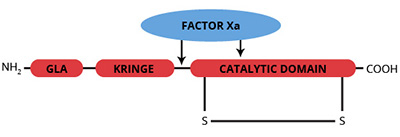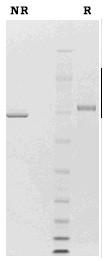Prothrombin is a vitamin K-dependent plasma protein which is synthesized in the liver (1). Prior to secretion into plasma, prothrombin undergoes post-translational modification by a vitamin K-dependent carboxylase which converts ten specific glutamic acid residues to γ-carboxyglutamic acid (gla). The ten gla residues are located within the first 40 amino acids of the mature protein and contribute to the ability of prothrombin to bind to negatively charged phospholipid membranes. Prothrombin contains two regions of internal homology which are referred to as “kringle” structures. These regions of conspicuous secondary structure are located between residues 40 and 270 of the mature plasma protein and replace the growth factor domains found in several other plasma serine proteases. Thus far, no function has been ascribed to these regions, but there is suspicion that they may play a role in one of several binary protein interactions involving prothrombin. The mature single chain protein circulates in plasma as a zymogen and, during coagulation, is proteolytically activated to the potent serine protease α-thrombin. This proteolysis is catalyzed by the prothrombinase enzyme complex. During activation, prothrombin is cleaved at Arg271-Thr272 (human) / Arg273-Thr274 (bovine) and at Arg320-Ser321 (human) / Arg323-Ser324 (bovine) to a “pro” fragment (fragment 1.2) and thrombin, the latter of which is composed of two chains covalently linked by a disulfide bond. In the case of human prothrombin/thrombin, there is an additional thrombin feed-back cleavage at Arg284-Thr285 resulting in an additional 13 amino acids being removed from the mature thrombin “A” chain.
Human prothrombin is prepared from fresh frozen human plasma as described by Bajaj and coworkers (2). Bovine prothrombin is prepared from fresh bovine plasma using a modification of the procedure described by Owen and coworkers (3). Purified prothrombin is supplied in 50% (vol/vol) glycerol/H2O and should be stored at -20oC. Purity is determined by SDS-PAGE analysis, and activity is measured by clotting and/or chromogenic substrate assay, following conversion of prothrombin to thrombin.


